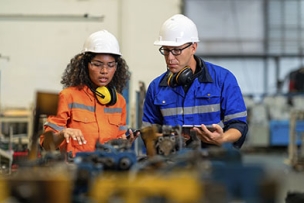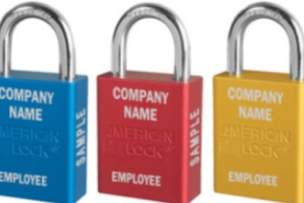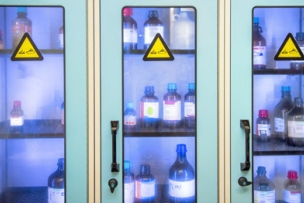The Invisible Danger: How to Protect Against Indoor Air Pollutants
Here’s how to fit your staff with the right ventilation system and proper protective gear to combat against indoor air pollutants.
Invisible to the eye, indoor air pollution is a particularly dangerous workplace hazard because symptoms are commonly mistaken for the flu. Here’s how businesses can protect their staff and adhere to OSHA regulations and standards from the ACGIH on air quality.
In manufacturing, it’s often the hazards seen on the shop floor that we’re most aware of and ready to thwart with the proper training and PPE: sharp grinding wheels and cutting tools, high-height ladders, icy, snowy footpaths or lockout/tagout procedures. But despite the heightened drama associated with these workplace dangers, some of the most prominent perils are the ones we can’t see. Case in point: air pollution.
To be clear, we’re not talking about billowing clouds of thick smoke or smog in an outdoor environment. In manufacturing, air pollution pertains to indoor conditions––where pollutants can be two to five to even 100 times higher than outdoor levels, according to the Environmental Protection Agency. Symptoms commonly associated with the flu, such as dry, watery eyes, itchy throat, constant sneezing or even nausea, are often present in “sick building syndrome,” or the health complications that arise from poor indoor air quality. But it’s not just a matter of flu-like symptoms causing workers to take more sick days––prolonged exposure to polluted indoor air can lead to more serious conditions, like a reduced IQ, asthma, reproductive disorders, hormone disruptions and even cancer.
Despite the danger associated with indoor pollutants in the manufacturing workplace, there are steps businesses can take to ensure their staff is safe.
Where Are the Pollutants Coming From?
Just as no two manufacturers produce the same product, no two shops will bear the same type of indoor air pollution. However, the Occupational Safety and Health Administration lists a handful of examples where pollutants might be more prevalent in the manufacturing workplace:
- At a building suite or location where a high water table is present.
- At buildings with a design that allows pollutants in via the roof, foundation, doors, windows, or through outside air intakes placed near idling vehicles or waste containers.
- At buildings where the HVAC is not functioning properly.
- During a building renovation where chemicals and dust from painting may occur.
- As exhaust is ventilated through kitchens, laboratories, maintenance shops, toilet rooms, etc.
On or around building materials such as sprayed-on acoustical material or wet structural surfaces.
Per OSHA, these types of pollutants can be separated into three main categories: biological (such as viruses and fungi), chemical (such as gases and vapors) and particles (nonbiological substances such as dirt or dust). And while OSHA also details a list of green product alternatives for businesses, in manufacturing there’s often very little workaround––many volatile, toxic chemicals and pollutants cannot be made “green” without losing their effectiveness.
The question then becomes: Knowing their toxicity, how do you manage those pollutants?
“Clean is a subjective term and may mean different things to different facilities. If someone walks into a plant and sees a blue haze around the lights, he or she can surmise quickly that the facility has an air quality problem,” explains Jim Reid, managing director for RoboVent, in an article he wrote for The Fabricator. “But some problems aren’t as easy to spot, which is why manufacturers need to know exactly where their plant stands.”
Indoor Air Pollution Management: Where to Start
Before attempting to manage pollutants in the workplace, it’s crucial to have a solid understanding of the regulations and standards already set in place that pertain to air quality. Industrial operations are required to adhere to OSHA regulation 29 CFR 1910 Subpart Z, which includes 29 CFR 1904, 29 CFR 1910.94 (ventilation), 29 CFR 1910.1000 (air contaminants), 29 CFR 1910.1048 (formaldehyde) and 29 CFR 1910.1450 (occupational exposure to hazardous chemicals in laboratories). OSHA also sets in place permissible exposure limits for nearly all types of chemicals that exist in your shop––and could potentially pollute the air quality.
Again––no two manufacturers will produce the same indoor pollutant, so having a solid understanding of what type of chemicals your shop emits is crucial—and any particular regulations and standards for your industry. For example, welding, cutting and heating operations in the shipbuilding industry must comply to 29 CFR 1915 Subpart D, and construction is required to adhere to 29 CFR 1926 Subpart D in relation to gas, vapor, fume, dust and mist exposure.
OSHA regulations may not be enough to protect workers in metalworking, Reid points out [for more details on other standards used, see the sidebar “Beyond OSHA: Deeper Standards for Metalworking”]. Metalworking can be more than cutting, milling and grinding—it’s also about cooling the hot materials that come off machines with fluids that are often oil or water-based products that can produce harmful mist when inhaled.
Want to learn more about how to mitigate the chemical dangers in metalworking? Read “Exploring the Safety Dangers of Metalworking Fluids.”
Failure to comply with regulations and standards can result in considerable fines—sometimes in the hundreds of thousands of dollars, Reid says.
Shop owners will also need to map out how they will manage the danger. OSHA recommends three overarching approaches for eliminating or lessening the effect of air pollutants. The first surrounds source management: Is there a way to substitute for or remove the pollutant entirely? The next step would be engineering controls, which includes ventilation systems and personal protective gear, including respirators and masks. The third approach surrounds administrative controls: If removing the pollutant isn’t possible, can the time workers spend around the equipment be reduced––or can the pollutant or chemical simply be moved?
"Clean is a subjective term and may mean different things to different facilities. If someone walks into a plant and sees a blue haze around the lights, he or she can surmise quickly that the facility has an air quality problem. But some problems aren't as easy to spot, which is why manufacturers need to know exactly where their plant stands."
Improving Manufacturing Air Quality: Ventilation and Respirators
Naturally, the first and third approaches to pollutant management are the most optimal, as any chance a manufacturer has to remove his or her employees from a dangerous substance the better. But in the event that working with or alongside a chemical is part of the job, choosing the right ventilation system and personal protective equipment is crucial.
Specifically, when opting for a dust or fume collector, being precise is critical, explains Chris Felix, senior editor, in an article for Production Machining. “Creating an effective ventilation system requires consideration of a range of variables, from the type of dust and fumes produced to the airflow dynamics that carry the particulates and pollutants throughout the plant,” writes Felix.
Proper contaminant collection and well-designed ventilation that helps keep fresh airflow in a manufacturing setting is only one part of the full facility-safety equation. The other way to help avoid indoor air pollutants is through a job-specific respiratory system. Respirators fall into two main categories: filtering and air supply. Filtering respirators prevent airborne particulars from reaching the nose and lungs. An air supply system ventilates clean air directly to the wearer so contamination stays outside of the mask.
OSHA outlines specific standards relating to respiratory protection under 29 CFR 1910.134, which requires employers to fit their staff with respirators in the presence of harmful dusts, fogs, mists, gases, smokes, sprays or vapors. The masks themselves range in types, from full-facepiece Elastomeric (which are easy to seal around the entire face) to PAPR respirators (with blowers that pull air through filters) to airline respirators (which clean through a long hose that is attached to a clean source).
Need help finding a respirator? Read “PPE Selection: Find the Right Type of Respirator.”
“Over the last few months we have seen significantly increased concern and interest from welders and welding organizations related to respiratory protection,” explains Ken Henry, director of sales for CleanSpace Respirators, in an article for OH&S. “In particular, we are seeing a strong demand for PAPR respiratory solutions that can provide a high-efficiency (HEPA P100) particulate filter to protect against mechanically and thermally generated particles and that are light, comfortable, and compact and easily fit under existing welding hoods and grinding visors.”
The most important aspect to choosing a respirator is the fit. Employees can shy away from wearing protective gear, and face masks and respirators are no exception to this. The best way to ensure the wearer is comfortable in his or her respirator is to conduct a fit test long before the first day on the job. OSHA requires tight-fitting respirators to be fit tested yearly to ensure that the facepiece creates a tight seal around the user’s face. Loose-fitting respirators don’t require fit testing.
How does your shop manage its indoor air quality? We want to know.





Talk to Us!
Leave a reply
Your email address will not be published. Required fields are marked *